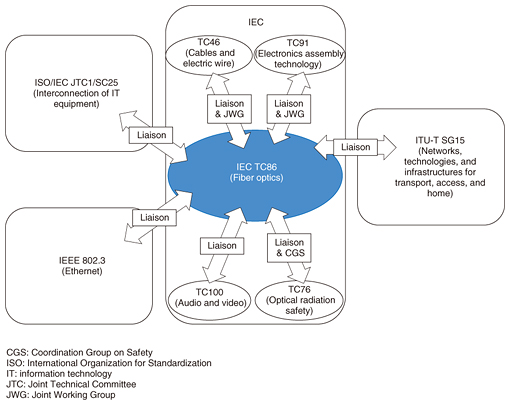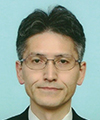 |
|
|
|
|
|
Global Standardization Activities Vol. 14, No. 11, pp. 56–61, Nov. 2016. https://doi.org/10.53829/ntr201611gls Standardization Activities in International Electrotechnical Commission Technical Committee 86 (Fiber Optics)AbstractThe International Electrotechnical Commission Technical Committee 86 (IEC TC86) is an international standardization organization that prepares and decides on international standards in relation to products used for optical fiber telecommunication. In this article, we provide an overview of standardization activities, introduce topics discussed at meetings in 2015 and 2016, and describe the Japanese standardization strategy in IEC TC86. Keywords: IEC, optical fiber, international standard 1. IntroductionThe International Electrotechnical Commission (IEC) is a standardization organization that sets all of the required standards for electrical and electronics technologies. It develops international standards for product specifications and provides a conformity assessment regarding the safety and quality of products. The scope of Technical Committee 86 (TC86) is to prepare standards for fiber optic systems, modules, devices, and components intended primarily for use with communications equipment. This activity covers terminology, characteristics, related tests, calibration and measurement methods, functional interfaces, and optical, environmental, and mechanical requirements to ensure reliable system performance. The technical scope of IEC TC86 is shown in Fig. 1, and its structure is indicated in Fig. 2. TC86 has three subcommittees (SCs) that can make decisions: SC 86A concerns fibers and cables, SC 86B concerns fiber optic interconnecting devices and passive components, and SC 86C concerns fiber optic systems and active devices. The TC and SCs have 13 Working Groups (WGs) that engage in technical discussions regarding standards documents. The number of published documents and the documents under discussion in the TCs are indicated in Fig. 3. TC86 is one of the largest TCs in the IEC and is responsible for the preparation of 400 or more standards documents. More than 300 experts from 30 countries are participating in the related discussions.
2. Recent fiber optics standardization topicsThe standardization of optical fiber cables and connecting devices for fiber optics has been aggressively discussed for use in access network systems because of the rapid growth of FTTH (fiber-to-the-home) services throughout Europe and developing countries. SC 86A has established a new international standard for optical fiber ribbon, which included the Japanese proposal of partially bonded ribbon. New test procedures for optical fiber cables have been proposed by several (mainly European) countries that take into account the different environments and installation methods used in those countries. Japan also proposed standardizing a new test procedure for the friction coefficient between cables, and this proposal has been accepted. SC 86B holds active discussions on standardizing field mountable connectors, which are fusion splice connectors for use in Europe and mechanical splice connectors for use in Japan. IEC TC86 works closely with the International Telecommunication Union - Telecommunication Standardization Sector (ITU-T) Study Group 15 (SG15) to define the functional requirements for public fiber telecommunication networks. The development of a standard for optical connectors is being discussed separately under collaboration between ITU-T and IEC, and the functional requirements are being considered in ITU-T and the product specifications in IEC. In view of the huge growth of datacenter technology recently, increasing attention has been focused on developing standards that take datacenter use into consideration. In particular, in SC 86C, the standardization of photonic integrated circuits (PICs) has been discussed, and TC86 decided to develop new standards for PICs in SC 86C/WG4 in 2015. SC 86A has accelerated discussions related to revising product specifications and test procedure standards for multi-mode fibers, which are used for short reach communications over less than several hundred meters in datacenters. SC 86B has discussed performance specification standards for multiple-fiber push-on/pull-off (MPO)-type optical connectors, which are used to connect fiber ribbons and optical transceivers for parallel transmission. The fiber optics technologies discussed in TC86 cover many industries including automotive communication, sensing, smart grids, and industrial automation. TC86 is proceeding with standardization efforts in collaboration with various standardization organizations. The collaboration structure in TC86 is shown in Fig. 4. ITU-T SG15 is very closely related to TC86 in dealing with systems and products used in public telecommunication. ITU-T SG15 and TC86 share information and exchange inquiries and respectively discuss functional requirements and product specifications. For smart grid technology, which uses both power lines and telecommunication lines, TC86 established a liaison with TC46, which discusses standards for coaxial cables. In addition, SC 86A established a joint WG with SC 46C.
SC 86C established WG2 to study optical sensors in 2013 in order to address the use of fiber optics in sensing applications. Academia and measurement instrument manufacturers in Japan and Italy play a central role in discussing the standardization of optical sensors in SC 86C/WG2, and WG2 has discussed establishing standards for optical temperature and strain sensors as an urgent issue. 3. Latest topics(1) SC 86A/WG1: Optical fibers WG1 has finished the comment resolution for new product specifications and test procedures for a polarization-maintaining optical fiber proposed by Japan and has agreed to accelerate discussion toward establishing new standards. WG1 has also agreed to revise the product specifications of A1 type multi-mode optical fiber (IEC 60792-2-10) to include a new product, namely, wide-band multi-mode optical fiber for wavelength-division multiplexing transmission. (2) SC 86A/WG3: Optical cables WG3 agreed to circulate a modified draft of a new standard for optical fiber ribbon that Japan had proposed. There was an active discussion on adding new test procedures and improving the existing tests for optical cables, and WG3 agreed to include unchanged the procedure proposed by Japan for testing the friction coefficient between cables. WG3 also agreed to initiate a new topic concerning optical cable for shared use both inside and outside. (3) SC 86B/WG4: Standard tests and measurement methods for fiber optic interconnecting devices and passive components Japan proposed a method for testing the strength of a mounted adapter, and WG4 agreed to circulate the revised draft. Many proposals were made that were related to new topics such as the visual inspection of fiber optic connectors and the measurement of fiber angle and position in a multi-fiber connector ferule by utilizing a computed tomography scan. (4) SC 86B/WG6: Standards and specifications for fiber optic interconnecting devices and related components WG6 agreed to change the spring strength to 20N in the interface specifications of the 2-fiber-row MPO connector. WG6 is continuing to discuss the loss of a field mountable connector at a wavelength of 1625 nm since Japan insisted on considering existing products. (5) SC 86B/WG7: Standards and specifications for fiber optic passive components Japan proposed changing the document structure of the generic standard for optical isolators. SC 86B held a joint meeting of WG6 and WG7 to consider a generic guideline for the performance standard of optical passive components, and discussed the definition of the closure and strength test for fiber clamps. (6) SC 86C/WG1: Fiber optic communications systems and sub-systems WG1 discussed revising the generic standard for the optic sub-system that Japan proposed and also discussed a method to measure loss in multi-mode fiber transmission lines, a method to measure polarization mode dispersion in transmission lines, chromatic dispersion compensation methods, and PON (passive optical network) system loss measurement. (7) SC 86C/WG2: Fiber optic sensors New standards for fiber Bragg grating based strain sensing (IEC61757-1-1) and distributed temperature sensing (IEC61757-2-2) were published in 2016. Japan proposed standardizing electric current sensing, and WG2 agreed to discuss it as a new issue. WG2 plans to discuss fiber Bragg grating based temperature sensing, distributed vibration sensing, and distributed strain sensing. (8) SC 86C/WG3: Optical amplifiers WG3 discussed a new draft and the subject of a new project. SC 86C held a joint meeting of WG3 and WG4 on the standardization of the semiconductor optical amplifier and discussed in particular a gain ripple measurement method. (9) SC 86C/WG4: Fiber optic active components and devices WG4 discussed new drafts concerning PIC packages and radio over fiber. WG4 also discussed a performance template for a semiconductor optical amplifier in a joint meeting with WG3. (10) SC 86C/WG5: Dynamic modules and devices WG5 discussed new drafts for the performance template of a multi-cast optical switch and the transient crosstalk measurement of a wavelength selective switch. WG5 agreed to investigate tests concerning the reliability and high power resistance of dynamic modules. (11) TC86/WG4: Fiber optic test equipment calibration Comments and voting results of a draft method for calibrating an optical spectrum analyzer were confirmed and published. WG4 agreed to develop the technical specifications for the optical frequency analyzer calibration method as an international standard in the future. (12) TC86/JWG9: Optical functionality for electronic assemblies JWG9 (Joint Working Group 9) confirmed a liaison request from the Consortium for On-Board Optics (COBO) and agreed to establish the liaison after a decision had been reached in TC86. 4. Further standardization activities of TC86The secretary of SC 86B, the chair of SC 86C, the conveners of several WGs, and many project leaders of standards discussions are from Japan. The Japanese influence in TC86 is strong, and we lead the standardization discussions in order to communicate the superiority of Japanese technologies. We are also proceeding with domestic collaboration between ITU-T and IEC for strategic standardization activities involving both standardization organizations. Recently, the discussion has spread to new application areas such as datacenters and automotive applications, and collaboration is under way with participants in other standardization bodies such as ITU-T and the Institute of Electrical and Electronics Engineers (IEEE). In June 2016, IEC President Junji Nomura, IEC General Secretary Frans Vreeswijk, and James Shannon, the IEC President-Elect, visited NTT headquarters in Tokyo and discussed a master plan for a standardization strategy for the next five years. At this meeting, they discussed the importance of both the standardization of industrial products and the Internet of Things, the system standard for smart cities, and conformity assessment. TC86 is planning to deal with these topics strategically and to strengthen collaboration with standardization bodies such as ITU-T that discuss system requirements. |
|















